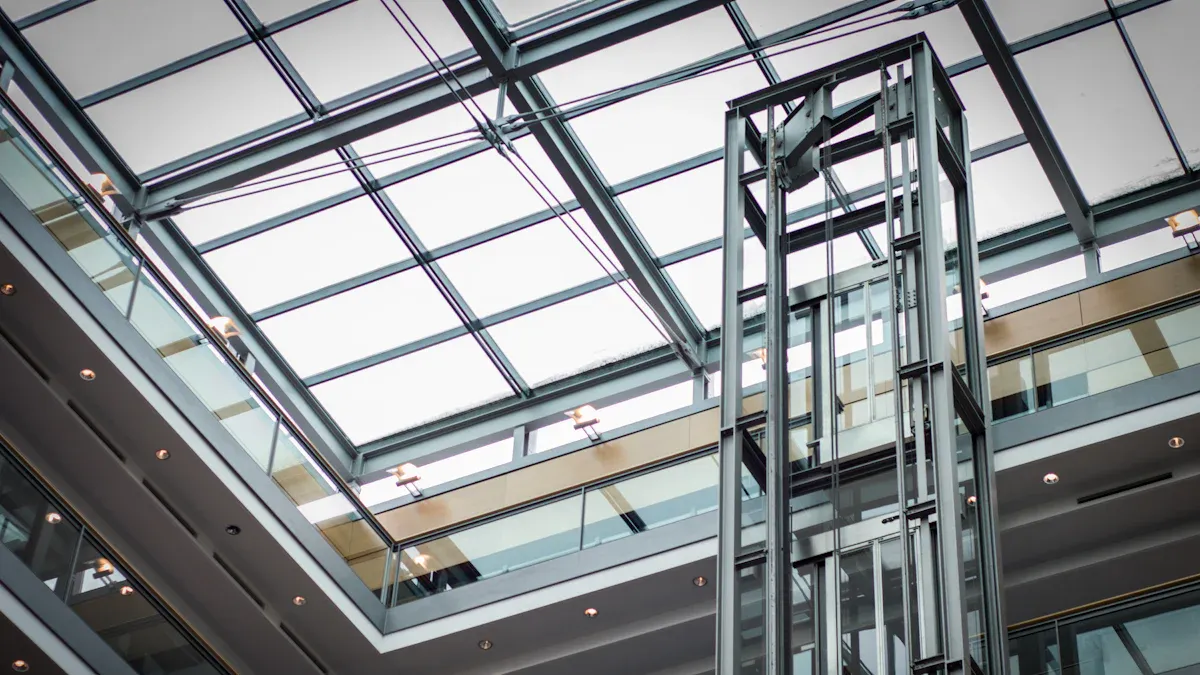An elevator project for your home follows a clear, multi-step process. You will move from planning to the final inspection. Understanding each step helps you manage your timeline and budget. This process ensures your new elevator is safe and fits perfectly into your home.
The residential elevator market is growing quickly in North America. This growth is due to an aging population and a desire for luxury home features. The market is expected to expand significantly in the coming years.
| Market Growth Metric | Details |
|---|---|
| Market Size in 2025 | USD 23.48 Billion |
| Market Size in 2033 | USD 33.6 Billion |
| Growth Rate (CAGR) | 4.58% |
A residential passenger elevator can be a valuable addition to any home.
Phase 1: Initial Planning and Consultation
The first phase of your project is all about planning. You will define your goals and talk with experts. This step sets the foundation for a smooth installation.
Defining Your Needs and Goals
First, you should think about why you want an elevator. Your reasons will guide your choices. Many homeowners install elevators for specific benefits.
·Convenience and Safety: An elevator makes it easy to move groceries or laundry. It also reduces the risk of falling on stairs.
·Independence and Accessibility: A residential passenger elevator gives you freedom to move around your home. It provides full access for people with mobility challenges.
·Future-Proofing: Installing an elevator helps you age in place and can increase your home’s value.
Tip for Accessibility: If your goal is accessibility, consider features like wide doors for wheelchairs, handrails, non-slip flooring, and emergency phones. These elements ensure the elevator is safe and easy for everyone to use.
Initial Consultation and Site Evaluation
Next, you will meet with an elevator professional. They will visit your home to evaluate the space. A standard elevator often needs about 20 to 25 square feet. The expert will identify the best location and check your home’s structure. This is a great time to ask important questions.
Be prepared for your consultation. Ask your potential installer about their experience, safety features, customization options, and what the total estimate includes. This helps you choose the right partner for your project.
Understanding Budget and Financing Options
Your budget is a key part of the plan. The cost of an elevator depends on its type, size, and features. Installation costs can vary widely.
| Elevator Type | Average Cost Range |
|---|---|
| Shaftless | $15,000–$25,000 |
| Hydraulic | $25,000–$50,000 |
| Pneumatic (Vacuum) | $35,000–$60,000 |
Many financing options can help you manage these costs. You can explore home improvement loans from banks or specialized lenders. Some elevator companies also offer direct financing plans with flexible payment terms.
Phase 2: Elevator Selection and Design

After planning, you will choose the elevator’s core components and appearance. This phase is exciting because you get to design an elevator that fits your home and style. Your decisions here will affect performance, cost, and aesthetics.
Choosing the Right Drive System
The drive system is the engine of your elevator. Each type has unique benefits. Hydraulic and traction systems are common choices. Pneumatic elevators are a modern option that uses air pressure. They install quickly and do not need a separate machine room or pit.
Traction elevators are energy-efficient and do not require a machine room. Hydraulic elevators are known for being very quiet. You can compare the main drive systems below.
| Feature | Traction Elevator | Hydraulic Elevator |
|---|---|---|
| Pros | Energy-efficient, no machine room needed, smooth ride. | Very quiet operation, great for low ceilings, lower install cost. |
| Cons | Can be less quiet than hydraulic models. | Needs space for a separate machine room. |
| Best For | Retrofitting homes, saving space, energy savings. | The quietest possible ride, homes with low ceilings. |
Selecting a Residential Passenger Elevator Model
Next, you will select an elevator model. Models vary by size and weight capacity. A typical residential passenger elevator can hold between 900 and 1,500 pounds. The cab size often relates to its capacity. A larger cab must support more weight. Think about your needs. Will you carry multiple people, a wheelchair, or heavy items? Your choice should match your daily use.
Design Tip: Consider the elevator’s entry and exit points. Some models offer front, side, or rear openings. This flexibility helps the elevator fit perfectly into your home’s layout.
Customizing Cab Finishes and Features
You can customize your elevator to match your home’s decor. This is where you can add personal touches to the cab interior. Many options are available to create a unique look.
·Lighting: Choose from LED ceiling panels, decorative fixtures, or even shaft lighting. Smart lighting lets you adjust brightness from the control panel.
·Control Panels: You can select modern touchscreens or classic push-button panels.
·Walls and Flooring: Pick from various wood, laminate, or metal finishes for the walls. The flooring can match your home’s style.
These custom features make your elevator a beautiful and functional part of your home.
Phase 3: Engineering and Permitting
This phase moves your project from design to official approval. Your elevator company will create technical blueprints and work with local authorities. This ensures your installation is safe, legal, and structurally sound.
Creating Final Engineering Drawings
Your elevator professional creates final engineering drawings. These detailed plans are the technical guide for the installation. They provide exact specifications for every part of the project. The drawings ensure everyone involved understands their role.
Key information in these plans often includes:
·Hoistway Framing: Specific guidelines for building the elevator shaft.
·Structural Supports: Details on how to anchor the elevator for stability.
·Door Preparations: Specifications for installing different door lock mechanisms.
·Electrical Requirements: Plans for dedicated circuits, outlets, and lighting.
·Machine Room Layout: Drawings for the room housing the elevator’s machinery, if needed.
Structural Analysis of Your Home
Next, a structural engineer will analyze your home. The engineer confirms your house can support the elevator’s weight. Residential elevators have different weight capacities, such as 750 or 950 pounds. The analysis considers your home’s foundation and frame. For example, a concrete foundation can hold more weight than a wooden one.
Expert Tip: You will need stamped plans from a licensed architect or structural engineer. These official documents show that your home’s structure, including the foundation and hoistway, can handle the elevator’s load safely.
Securing Local Building Permits
You must get a building permit before construction begins. This step is mandatory and ensures your project meets local safety codes. Your elevator company usually helps you navigate this process with your local building authority.
Permit requirements vary by location. For example, some states require specific maintenance contracts to issue a permit. In California, you might need to:
1.Pass a state safety inspection.
2.Have a full maintenance contract with a licensed elevator company.
3.Submit a copy of the contract to the state authority.
Working with your installer makes this process much smoother. They know the local rules and can manage the paperwork for you.
Phase 4: Site Preparation
With your plans approved, your project now moves to the construction site. This phase prepares your home for the elevator installation. It involves creating the physical space for the shaft and setting up the necessary power. Proper site preparation is essential for a safe and efficient installation.
Locating the Elevator Shaft
You will work with your contractor to finalize the elevator’s location. The right spot depends on your home’s layout and your goals. You should think about how you will use the elevator every day.
·Functional Purpose: You might place the elevator discreetly in a closet for privacy. Or, you could make it a visible, stylish feature in an open area.
·Size Considerations: You need to account for the cab and shaft size. A compact elevator may fit in a small space. A larger one needs more room for multiple people or a wheelchair.
·Shaft-Less Options: Your home may have limited space. A shaft-less elevator is a great alternative. It does not need a long, traditional hoistway and fits in many locations.
Performing Necessary Structural Modifications
Your home needs changes to support the elevator. A contractor will perform these structural modifications based on the engineering plans. This work ensures the elevator operates smoothly and safely.
These modifications often include:
·Reinforcing the hoistway to support the guide rails and moving parts.
·Strengthening the shaft to handle dynamic loads and vibrations.
·Building a deep pit for certain systems, like hydraulic elevators.
·Adding fireproofing materials and seismic bracing for safety.
·Ensuring the structure can bear the full load of the car and its occupants.
Arranging for Dedicated Electrical Power
Your elevator requires its own electrical circuits. You must hire a licensed electrician for this work. They will install the wiring according to the elevator’s specifications and local codes. This step is critical for safe operation.
Power Requirements Checklist
A typical installation needs:·A dedicated 220V, 30-amp circuit for the main elevator power.
·A separate 120V, 15-amp circuit for the cab lighting.
·A live telephone line connected to the controller for emergencies.
·An outlet and lighting inside the machine room, if your model has one.
Phase 5: Hoistway Construction and Installation

Your project now enters the main construction phase. Your contractor will build the elevator’s structure and install the machinery. This is where your elevator truly takes shape.
Constructing the Hoistway and Pit
First, your contractor builds the hoistway. This is the vertical shaft where the elevator will travel. A standard hoistway for a residential elevator often measures around 5 feet by 4 feet. This provides enough space for the car and its components.
Next, the team creates a pit at the bottom of the hoistway. The pit depth depends on your elevator model. It can range from 6 to 12 inches deep, but most elevators need a pit of about 8 inches. This space houses important equipment and provides a safety buffer.
Installing Rails, Car, and Machinery
With the hoistway ready, the installation team begins its work. This process typically takes 4 to 6 weeks. Technicians will carefully install all the core components.
Post time: Nov-04-2025
